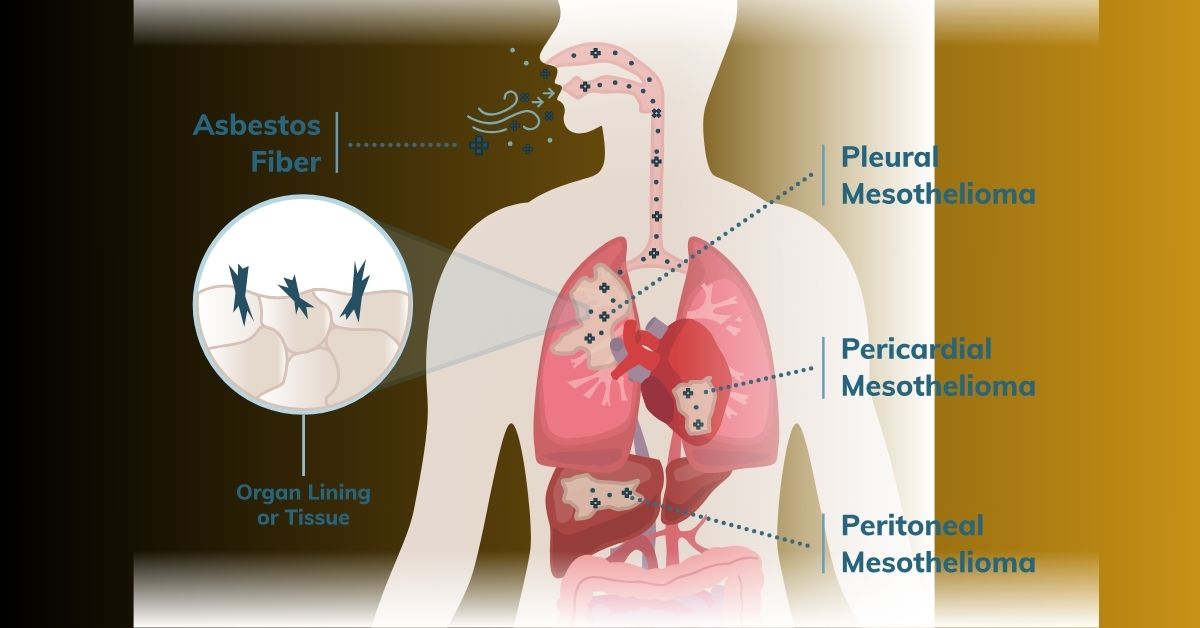Malignant mesothelioma, a rare and aggressive form of cancer, is primarily linked to asbestos exposure. This comprehensive blog post explores the causes, symptoms, diagnosis, and treatment options for mesothelioma, shedding light on the importance of early detection and tailored therapeutic approaches.
What is asbestos?
Asbestos is a mineral known for its strength, heat resistance, and insulating properties. Historically, it has found widespread use in various industries and construction due to its versatility.
Where is asbestos found?
Asbestos can be found in older buildings, insulation materials, roofing, flooring, and certain consumer products. Identifying and managing asbestos-containing materials is crucial to preventing exposure.
History of Asbestos Use and its Connection to Mesothelioma
The extensive use of asbestos, particularly in the 20th century, has left a lasting impact. Asbestos fibers, when inhaled or ingested, can lead to chronic health issues, with mesothelioma being one of the most severe consequences.
Common Industries and Occupations at Risk for Asbestos Exposure
Certain industries and occupations pose a higher risk of asbestos exposure. These include construction, shipbuilding, manufacturing, and firefighting. Understanding these risks is crucial to workplace safety.
Secondary Exposure to Asbestos and its Impact on Mesothelioma
Secondary exposure occurs when individuals come into contact with asbestos through contaminated clothing or equipment. Family members of those working in high-risk occupations may unknowingly face this risk.
Health Risks Associated with Asbestos Exposure
Asbestos exposure is associated with various health risks, including lung cancer, asbestosis, and, most notably, mesothelioma. The latency period, often spanning several decades, underscores the insidious nature of these health risks.
Diagnosing Mesothelioma: Tests and Procedures
Accurate diagnosis of mesothelioma involves a series of tests and procedures, including biopsies, blood tests, and imaging scans. Early detection is crucial for effective treatment.
Stages of Mesothelioma and Treatment Options
Understanding the stages of mesothelioma is vital for determining appropriate treatment strategies. Treatment options include surgery, chemotherapy, immunotherapy, and radiation, often employed in combination for better outcomes.
Surgical Interventions for Mesothelioma
Surgery plays a pivotal role, especially in the early stages. Procedures may involve tumor removal, pleurectomy, or decortication, depending on the cancer’s location and extent.
Chemotherapy and Radiation Therapy for Mesothelioma
Chemotherapy and radiation therapy aim to target and eliminate cancer cells. These treatments can be used independently or in conjunction with surgery for a more comprehensive approach.
Integrative and Alternative Treatment Options
In addition to conventional treatments, integrative and alternative therapies, such as acupuncture and dietary changes, may complement the overall well-being of mesothelioma patients.
Managing Symptoms and Improving Quality of Life
Supportive care focuses on managing symptoms, reducing pain, and enhancing the quality of life for mesothelioma patients. This holistic approach involves a specialized branch of medicine to address the unique needs of individuals facing this diagnosis.
Coping with a Mesothelioma Diagnosis
A mesothelioma diagnosis can be overwhelming. Coping strategies, including mental health support and counseling, play a crucial role in helping patients and their families navigate this challenging journey.
Causes:
Asbestos Exposure and Mesothelioma
• Asbestos exposure is the leading cause of mesothelioma.
• Repeated exposure to asbestos-containing products increases cancer risk.
• Asbestos fibers lodge in organ tissues, causing irritation and DNA damage.
• Mesothelioma latency period: 20–60 years, emphasizing early detection.
Symptoms:
Mesothelioma Symptoms
• Pleural mesothelioma: painful cough, shortness of breath, chest pain.
• Peritoneal mesothelioma: abdominal swelling, nausea, and pain.
• Pericardial mesothelioma: breathing difficulties, chest pains.
• Testicular mesothelioma: swelling or mass on a testicle.
Diagnosing Mesothelioma:
A definitive mesothelioma diagnosis requires a biopsy, where a tissue sample is examined for specific malignant mesothelioma cells. Blood tests and imaging, including chest X-rays, CT scans, MRIs, or PET scans, are crucial in confirming the presence of abnormalities. Early detection is vital for effective treatment and an improved prognosis.
Staging and Prognosis:
Mesothelioma is staged from 1 to 4, based on tumor size and spread. In the early stages, localized tumors offer a higher survival rate, with surgery being the most effective treatment. As the cancer progresses, spreading to nearby tissues, organs, or distant organs, the prognosis becomes more challenging. The median life expectancy for pleural mesothelioma ranges from 14.9 to 22.2 months, emphasizing the need for prompt diagnosis and intervention.
Treatment Options:
Mesothelioma treatment is multifaceted, involving surgery, chemotherapy, immunotherapy, and radiation. In the early stages, a combination of these modalities, known as multimodal therapy, has shown promising results. Surgery, such as tumor removal, pleurectomy, or decortication, is most effective in localized cases. Chemotherapy targets and kills cancer cells, while immunotherapy boosts the immune system to combat the disease. Radiation is often used to shrink tumors or alleviate symptoms.
Supportive Care and Prevention:
Supportive care plays a crucial role in improving the quality of life for mesothelioma patients. It focuses on alleviating pain, increasing appetite, and boosting morale. Prevention involves avoiding asbestos exposure, especially in occupational settings. Regular monitoring of individuals with a history of asbestos exposure through X-rays and other tests is recommended to catch cancer early.
Legal Options for Mesothelioma Patients
Those diagnosed with mesothelioma due to asbestos exposure may explore legal avenues for compensation. Legal options can help ease the financial burden associated with medical expenses and loss of income.
Support and Resources for Mesothelioma Patients and their Families
A robust support network is essential for those affected by mesothelioma. Various organizations and resources offer assistance, guidance, and a sense of community for patients and their families.
Prevention of Asbestos Exposure and Mesothelioma Development
Preventing asbestos exposure is key to reducing the incidence of mesothelioma. Strict adherence to safety regulations, proper handling of asbestos-containing materials, and regular workplace monitoring contribute to prevention efforts.
Ongoing Research and Advancements in Mesothelioma Treatment
The field of mesothelioma research continues to evolve, with ongoing efforts to explore new treatment modalities, improve early detection methods, and enhance overall patient outcomes.
Conclusion:
Understanding mesothelioma requires a comprehensive grasp of its causes, symptoms, diagnosis, and treatment options. Asbestos exposure remains the primary culprit, underscoring the importance of prevention and early detection. Advances in multimodal therapies offer hope for improved outcomes, emphasizing the need for tailored treatment plans based on cancer location, cell type, and stage. Mesothelioma awareness, coupled with ongoing research, holds the key to better managing and ultimately overcoming this challenging disease.



